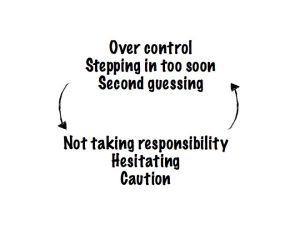I talk with many managers–and some coaches–who complain that their teams can’t function without a leader. “Leader,” in these conversations, usually means someone who set standards, assigns work, tracks progress, tells people what to do.
That is not how I would define a leader. However, it is a pretty common definition–applied from team lead to top management.
It is true that some teams need a leader, at some times. Occasionally, I run into a software teams whose members are all recent college graduates. Those teams need guidance. It might well be folly take a group with no real work experience, write a team charter and then set the team loose. Oh, wait. That’s how some really big tech companies started–and sometimes they weren’t even graduates yet…or in college. So it depends.
Situational Dependency
When I see a team of experienced professional relying on someone else to give day to day direction, make decisions, assign work and track progress, I suspect something else is at play.
I assume most adults are not utterly dependent people. They make important choices. Outside of work, they enter into major financial contracts such as taking out a mortgage. They make short and long term decisions about health and investments. Pay their bills. Many of them take the awesome responsibility of raising children.
Navigating life is as challenging as identifying edge cases for testing, designing a data base or writing an algorithm. You’d think such people could make decisions at work.
What happens to render people dependent–incapable making decisions or managing their own work without supervision?
A Dependency Dynamic
People respond to the system they’re in. The pattern of behavior is a response to the environment and management actions. Without intending to, managers may create a dependency dynamic.
Here’s how it works.
A manager–let’s call him Ted–tells a team he wants them to take more responsibility and be more empowered.
This is waaaaay different than the Ted the team has come to know. So the team hesitates.
Ted urges the team to step up. He crosses his arms over his chest and waits. The team hesitates some more. They begina discussion, tentatively. All the while, they look over their shoulders to see how Ted is reacting.
In this dynamic, one of two things usually happens. In one scenario, the team comes back with a decisions or takes a course of action that Ted thinks is a bad idea. So he countermands the decision. In the other, Ted, impatient with the time the team is taking to make a decision or act, tells them what to do.
You can guess what happens next. The team takes Ted at his actions, not his words. They know that he didn’t really want them to be more empowered and responsible. He wants to tell them what to do.
Once bitten, twice shy.
The next time Ted tells the team to be empowered team members sit back and wait. Ted can only take it so long before he steps in again.
And then you have this:
Eventually, action and reaction become a self-reinforcing dynamic.
Changing the Dynamic
The good news about dynamics is that they are not immutable. Dynamics can change.
Ted could work out decision boundaries with the team. He could provide more context. Ted might stop assigning work himself, He could then work with the team to establish a work queue and discuss goals for choosing work. Or he could start a conversation about how the team wants to be involved in various decisions. He could articulate what the desired outcome is, and what the boundaries are.
Working iteratively, he and the team could work their way out of dependence. Into responsibility.
Leader-ful
There are situations that call for one person to lead. Planning meetings, decision meetings, design sessions, customer conversations, and retrospective all benefit from having a leader. In these situations, the leader is one who provides a process and guides the group to think, learn, and decide together. Then it makes sense to have one leader. However, that doesn’t mean it’s a permanent position. It is far better for the team in the long run if it isn’t. That way, everyone practices leading a group. Eventually, you end up with a group of people skilled in leading.
Everyday presents opportunity for leadership in small and large ways. It might be asking a question, admitting that you don’t understand the proposal on the table. Summarizing, taking notes, Generating ideas or winnowing ideas, Keeping track of time, or checking to make sure everyone who wants to speak has that chance.
Teams need leadership and direction. Direction–defining the problem the team is chartered to solve–usually comes from management. But leadership comes from within the team and from all team members.
Leader-full, not leaderless, nor leader dominated.
Updated 2020.








(there’s a paradox in telling someone else to be empowered, isn’t there?)
In the last year I had people comming to me: help me to become empowered..
Well, I can see that. Sometimes people need some help in seeing just how many of their perceived constraints are self-imposed.
Nice post.
I encountered teams that had been so badly conditioned working in a command and control environment that they felt they needed a leader/manager. They needed her to tell them what to do as well as to take responsibility; Responsibility especially in case of failure.
Sometimes, unfortunately, one can wonder how some people manage to survive given how they behave at work :(. Empowering people is highly beneficial but sometimes resembles group therapy to wean people of need for this kind of leadership. Nevertheless, I still believe it’s worth every penny.
Why does leadership have to come from a single entity? I’d say that’s an urban myth propagated by movies. I ascribe to the ideas I learned on my road to Eagle Scout, that being that leadership is not about head down running head long into trouble, and it certainly is not about being a tyrant to those who you wish to lead.
Leadership is about inspiring others to buy in and contribute their unique gifts and talents to the accomplishment of some present activity or goal. Take the typical boy scout troop, each is divided into patrols, similar to project groups. While all patrols eventually will do similar things on their path to Eagle, not all will do them in the same order, or even all of the same ones, given that there are many electives.
Each Patrol has a Patrol Leader, and assistant Patrol leader voted on by their peers, but the leadership does not end there. Each patrol has a scribe, a record keeper of meetings, dues, and records what’s happened at meetings or outings. They also typically have a quartermaster, responsible for the Patrol’s equipment, to make sure it is maintained. Those are just a couple of examples.
In Software projects, this is no different, a typical team may have a number of developers, one may be focused on the front end GUI, one on the back end and database, another may deal with the business and data access layers, and then there may be testers as part of the team, and technical writers. Each brings a unique skill set and experience to the project, and all are valuable.
The question is how do you inspire each of those people to not just take ownership and do their job, but by in and lead as a group? The culture of the unit/division/company in question may play a role here. If it is a culture of blame, good luck getting buy in from the stakeholders who are more concerned in keeping their job until they find something better than perhaps working to make the process better.
Those are my initial thoughts any ways.
As usual, Esther, I have little to say but “ditto.” I wrote about this a little bit back in 2003, where I pointed out that there seem to be 2 types of behaviors which people both lump under the overloaded word “leader:”
http://derekwwade.net/blog/2003/03/04/what-is-a-leader/
I’ve tried to distinguish between the two types by using “boss” or “manager” for the first, and “leader” or even “facilitator” for the second, but there still seems to be some cultural/cognitive baggage that some folks carry around that perverts the meaning.
P.S.: Yay for causal-loop diagrams. One tool against simple, elegant, and WRONG fixes for complex situations. Why are these not taught more?